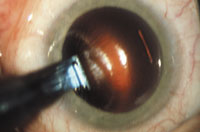 Q: I sent a patient for cataract surgery, and the physiological result is excellent. However, astigmatism is still present, and the patient is unhappy. Could this have been corrected at the time of surgery?
Q: I sent a patient for cataract surgery, and the physiological result is excellent. However, astigmatism is still present, and the patient is unhappy. Could this have been corrected at the time of surgery? A: Yes, it could have, as there are now at least three options for correcting pre-existing astigmatism during cataract surgery, says optometrist John W. Lahr, of Minneapolis.
The newest method is to use a toric intraocular lens. Dr. Lahr, who is a clinical consultant and a presenter for STAAR Surgical, says the other methods include expansion of the surgical incision or additional corneal incisions, such as a limbal relaxing incision or astigmatic keratotomy.
Collaborate with your surgeon to see which of the following options will be best for your patient, he says.
* Toric IOL. This newest option provides perhaps the most predictable optical outcome, according to Dr. Lahr. (Currently the STAAR lens is the only FDA approved toric IOL. However, Alcon Surgical has one that is in the final stage of approval. Additional choices may soon be available as well, Dr. Lahr says.) Depending on the IOL, the lens can correct approximately 1.50D or 2.50D of astigmatism. "Like a toric contact lens, you always want to pick a lens that will slightly undercorrect the patient," he says. "You don"t want to overcorrect, and shift the axis 90 degrees, for example, taking a patient from with-the-rule astigmatism to against-the-rule."
* Expansion of the surgical incision. Another option is for the surgeon to correct the patient"s astigmatism by expanding the corneal incision used to insert the IOL. The surgeon puts the incision in the steepest meridian of the cornea, and makes the incision slightly larger than the traditional 3mm. This may provide for up to 0.50D of flattening in that meridian, Dr. Lahr says. For a better result, expansion of the surgical incision might also be performed in combination with an astigmatic keratotomy (AK) or limbal relaxing incision (LRI).
* AK or LRI. Astigmatic keratotomy is an incision performed directly on the cornea, in the steepest meridian. LRIs are gaining more favor. The surgeon places these incisions in the far peripheral aspect of the cornea at the limbus, so they usually do not result in glare and haloes. AK is typically performed for refractive errors from 0.50D to 4.00D of astigmatism.
 Courtesy: Harry Grabow, M.D. |
| Astigmatic keratotomy pre-phaco with Feaster (Rhein) 3.0-mm diamond blade. |
LRIs are often performed for milder degrees of astigmatism (perhaps up to 2.50D), because they provide less flattening due to their distance from the central cornea, Dr. Lahr says.
Each surgeon does his or her incisions a little differently, Dr. Lahr says. Some make them a little deeper, which gives more effect, while others make them a little shallower. Some surgeons place the incisions in from the limbus slightly; while others place them at the limbal arcade. Again, collaborate with your surgeon to find out how much astigmatism correction can be achieved, and be sure to specify an undercorrection in order to avoid an overcorrection.
In terms of additional cost, some surgeons make an agreement with the patient to pay an out-of-pocket charge that ranges from $100 to $400, because the procedure is not covered by Medicare.
"Not all surgeons are adding an additional fee," Dr. Lahr says. "Some surgeons say it takes them only seconds to make these additional incisions, and they consider it a value-added service for these patients and their comanaging optometrists." But, he adds, as the surgical reimbursement for the cataract procedure continues to decline, more surgeons will likely charge for this in the future.
Q: What should I look for when patients return for post-op care? If I suspect toric IOL rotation, when do I refer the patient back to the surgeon? Also, what is the appropriate postoperative care for AK or LRI patients?
A: Each of the options mentioned has advantages and disadvantages. In the case of the toric IOL, check visual acuity to determine if lens rotation may have taken place.
"Although first day visual acuity is often less than 20/20, we don"t expect it to be 20/50," Dr. Lahr says. That would likely indicate the lens has rotated from the desired location.
The indicator marks on the IOL are visible under dilation. So, you dilate the eye, then orient the slit lamp vertically, and rotate it to wherever the marks are on the IOL. "You read it the same way you would read the amount of rotation on a toric contact lens, and then you know exactly where that lens is located," Dr. Lahr says.
If the lens has rotated, he says, refer the patient back to the surgeon. Day one, however, is not the day for repositioning because the capsular bag has not yet contracted around the lens to hold it in place. If the surgeon repositions the lens at this time, however, it would likely rotate out of position again. Therefore, advise the patient that a better time to reposition the lens is at about a week to 10 days after the initial procedure.
For AK or LRI, think of postoperative care as an incision or corneal abrasion. Thus, the usual post-operative topical antibiotic is standard, at least until the incision re-epithelializes, Dr. Lahr says. The patient could also use night-time lubricating ointment to prevent the lid from disturbing the re-epithelialization when he or she wakes up. The patient will also be on a steroid, which is typical for cataract surgery, to minimize any anterior chamber inflammation.
Vol. No: 141:10Issue:
10/23/04

